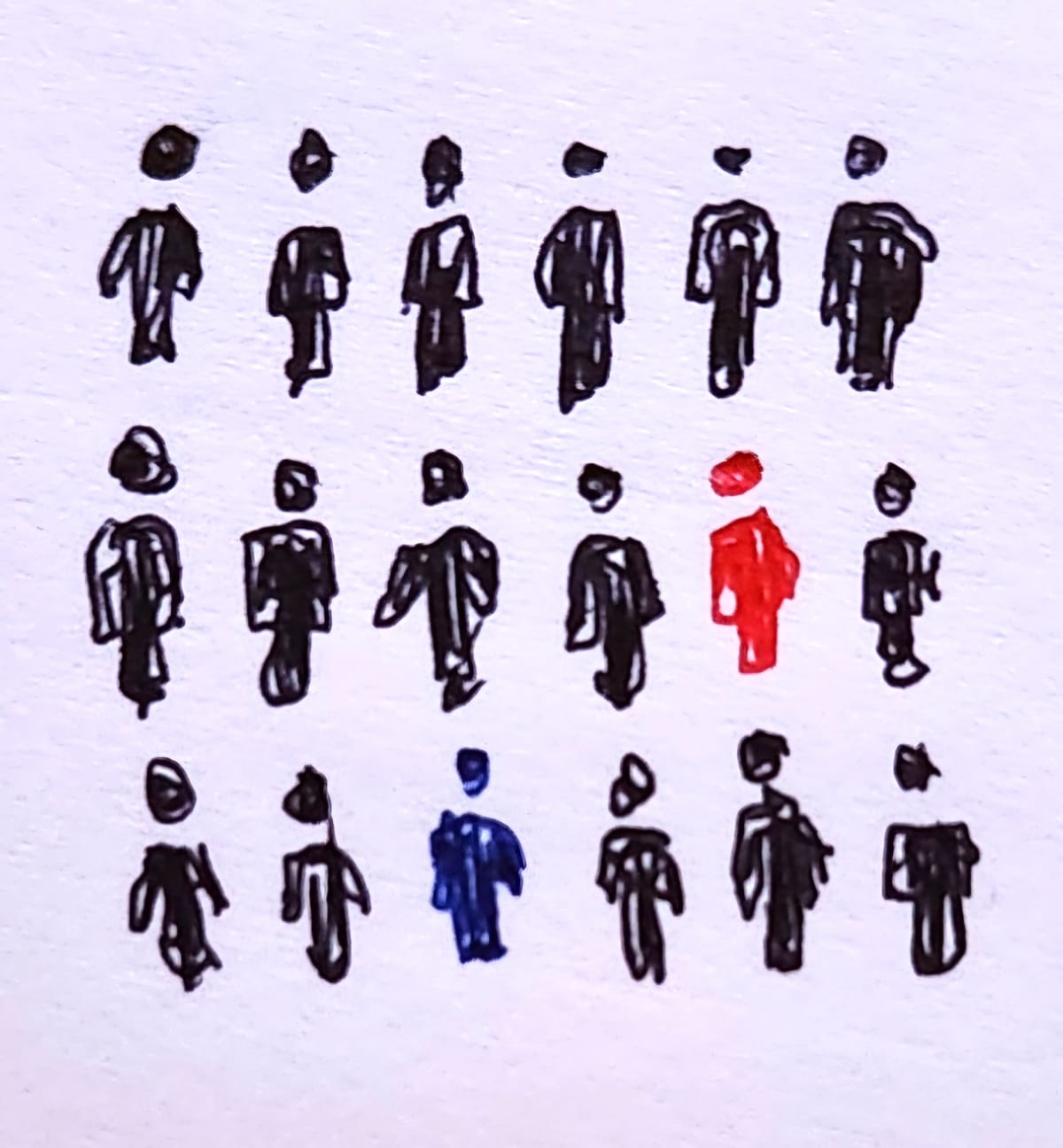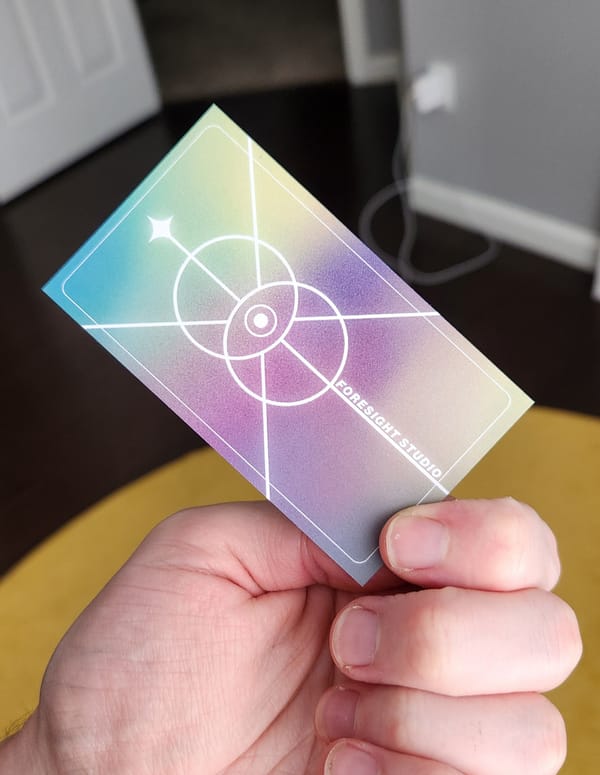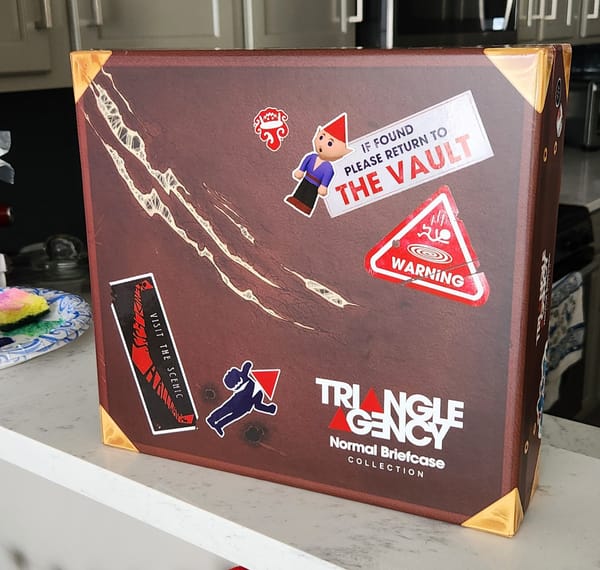Everybody's Special, Especially You
(we are so back)

Hi, it’s been a while! I had pretty grand ambitions when 2024 began, but in the last few months, I moved to a new state, officiated a wedding, started some big day-job transitions, had a scientific paper published, plus wrapped up a couple freelance layout projects I can’t wait for you to see—and there’s lots of work still to do. All that took up much more time and energy than anticipated, but here we are, finally, with some updates from the studio. And, I have some thoughts about asymmetric gameplay that have been brewing for a while, so I want to share those with you.
So, what’s been happening here?
- Layout on Triangle Agency is done! It looks amazing, if I do say so myself (and I do say so myself), and was only possible with of the work of a fantastic team. And guess what? It’s out (digitally) today!!! You can find it here at about 11am EST, along with The Vault, a companion volume of 12 missions (one of which I wrote!), here.
- Physical copies of The Cross Stitch are out of stock almost everywhere, except perhaps at your friendly local game store. I’m working on another print run, but given that I just moved, mental bandwidth/storage space/money is in short supply. I’ll update you all when it’s back, but in the meantime, you can still find The Cross Stitch digitally on Itch.io and DriveThruRPG.
- I’m returning to the handful of projects I left on pause with fresh eyes, and there’s a lot to sort through! So many ideas! I can’t give any specific timelines yet, since life is still just barely starting to settle down, but my very vague estimate is… I’ll have something out before the end of 2024.
- Not a Foresight Studio release, but I’ve been busy at my day job recently. Our latest research was published last month (link here, if you’re interested), and there’s more in the pipeline… and a lot of writing to do.
- I live in Vermont now! If you are (or if someone you know is) an indie TTRPG enthusiast in the general Burlington area, I’d love to find some community around here.
Now, asymmetry! I’ve divided this part into three sections:
- First, I’ll break down what I mean by asymmetry in games.
- Second, I’ll see how this applies to TTRPGs.
- Third, I’ll go through the psychology of uniqueness, belongingness, and why asymmetric games feel magic.
Thanks for reading Tomorrow//Today! Subscribe for free to support my work.
Life is a Game
I think of games as sitting on a rules-continuum with life. Life lacks inherent structure. There are no rules other than those made-up ones imposed by society and circumstance—with the exception of the (alleged) laws of physics (ew, no thank you). Games, on the other hand, are all about imposing (low-stakes) structure and then playing around inside of it.
Video games are perhaps the most extreme example. The rules of a video game are enforced by a computer you can’t negotiate around without some kind of backdoor. Board games sit a bit closer to life on that spectrum, and TTRPGs get even closer. As a game’s structure weakens, the possibilities for play spiral out as far as your imagination can take you.1
Asymmetry is built into many games’ structures, from the crunchy, rules-heavy ones to the squishy, rules-light ones. Here’s a working definition: asymmetry is when each player has some number of specific rules that apply only to them.
This is sometimes a feature of competitive games in the tabletop world—Root is a particularly extreme example—but it’s very often employed in collaborative games. There’s a couple clear reasons for this:
In a collaborative game, you need something to distinguish players from one another, or else the entire game could be beaten just as well (or better) by an individual.
Asymmetry is more difficult to balance than perfect symmetry, which can be frustrating in competitive play; in collaborative games, balance doesn’t matter quite as much.2
In asymmetric games, the rules that apply to each player usually converge on some shared goal or resource—defeating enemies, driving off invaders, adding or subtracting from a central pool, etc. In board games, the best of these strike a careful balance, with rules that live in a kind of Goldilocks zone: complicated enough that each player is kept engaged figuring out their own ruleset, but not so complicated that less experienced players get lost in the shuffle.3
Freed from the board, TTRPGs are a somewhat different case. As a shared worldbuilding exercise, asymmetry is inevitable, with each player bringing a perspective to the table that can directly affect how the in-game fiction unfolds. Focusing just on the rules as written, though, many demand asymmetry from the jump. Why?
Level 7 Lawful Evil Halfling Paladin of Vengeance
Making a character is one of the first things you do in most TTRPGs. You choose your class, pick your build, assemble your kit. You predict how your specific set of skills will help (or hinder) as you set out on your journey. You determine what will make your character unique.
Character creation serves a similar purpose to asymmetric rulesets in co-op board games: it defines specific identities so that player characters feel different from one another. While a cooperative board game might converge on a central mechanic, TTRPG rulesets converge on both mechanics and the shared fiction of in-game events.4 So, how distinct from one another do characters really need to be, mechanically-speaking?
In most games, characters are distinguished from one another both on fictional and mechanical axes. Characters have divergent backstories, personas, and connections with the world, and they also have a handful of scores, a jumble of abilities or skills or perks or feats—abstractions to help interact with the underpinnings of the game.5 I think the strongest argument that it’s important for characters to be unique comes in the form of those perfect moments when a player realizes that they can leverage both their backstory and skillset in a synergistic way to move the story forward. These moments make players feel not just powerful, but brilliant.
The thing is, I don’t think you absolutely need system-enforced difference between characters get those moments, at least not from the outset. The perspectives players bring to their characters already guarantee some amount of uniqueness. But if a game has avenues to meaningfully transform its characters over time, then each character will grow more and more unique as play continues. And if you’ve worked for your uniqueness, it’s that much more satisfying to put it into action.
Many of my favorite board and card games are like this, both co-op and competitive. You begin play largely symmetric, but build toward asymmetry as players add unique cards to their decks, pieces to their engines, or abilities to their characters to change the way they interact with the game. I find these games especially satisfying for reasons that connect to the way we live.6 We’re free of structure until we incorporate external norms and rulesets and patterns of accepted behavior, taking on roles and experiences and developing skills that distinguish us from our peers. Games show us a path by which this both isolates us and gives us community.
Not like other girls
There’s some compelling work in social psychology that describes a model of “optimal distinctiveness.” The idea is, there’s a particular degree of uniqueness that gives an individual a balance of both strong personal identity and the security that comes with membership within a larger group.7 Research suggests that the degree of distinction “optimal” for each individual will vary by their personality and cultural context. Sources of uniqueness are often a point of pride for an individual, and sometimes uniqueness is conferred by identification with a distinct, eccentric, or exclusive group—pursuit of uniqueness can even be a strong positive motivator on its own.8
Uniqueness is sometimes contrasted with “belongingness,” or other metrics scientists have developed to assess identification with a community.9 And when it comes to the intersection of belonging and TTRPGs, I’m gonna tell you something kind of obvious: games are a social activity. Engaging in gameplay is an act of identification with a group. At least, it is for the player.
The character is living a different story. When you play a TTRPG, your character is like, really going through it.
In a lot of ways, I think that’s the fun of asymmetric gaming. We can safely, securely simulate total uniqueness, along with all its power and distinction, its loneliness and isolation, while simultaneously reinforcing our social sense that we belong.10 Asymmetry in games lets us have our cake and eat it too.
To sum up: life is a kind of asymmetric game, as each of us gradually accumulates related-but-not-identical sets of “rules” in the form of the constructs and norms we inhabit.11 Asymmetry in TTRPGs is magical because we can reap the benefits (and understand the pain) of uniqueness while feeling even more connected to our communities.
So the next time you make a character, they’d better be a real weirdo.
Looking to the future,
Ben // Foresight Studio
As always, find me on tumblr or twitter (or cohost or bluesky or mastodon, though I can’t promise I’ll be active there). Or come hang out on the Foresight Studio discord server!
This can be something new players really struggle with. If there isn’t enough structure, players are sometimes left unsure of what options are even available to them. For all the hate D&D gets in the indie TTRPG community, this is a place it succeeds: by having a structured, board-gamey “combat mode” and a free-form “story mode,” new players have clear, obvious structure they can feel comfortable playing in. There’s also something to be said about how D&D’s reliance on tropes in concert with its place in the zeitgeist really does the heavy lifting in onboarding new players, but… that’s a discussion for another time. ↩
Though a lack of balance in collaborative games can feel nearly as frustrating. Although it won’t get in the way of the team prevailing, it can feel pretty bad to have multiple turns accomplishing nothing while other players blaze the path to victory. ↩
A bit more complexity also helps to ensure that one player can’t just commandeer the whole operation—they should be too busy puzzling out their own rules. But, as everything, this depends on who you play with. I’d especially highlight Spirit Island as a co-op game that uses asymmetry extremely well. ↩
What if the TTRPG isn’t co-op? Competitive TTRPGs do exist, and they can be a blast, but because your traditional RPG doesn’t really have a “win condition,” they aren’t so common. I think a competitive game doesn’t require as much asymmetry to be fun, because you’re constantly responding to unique situations being set by the other player(s). While it’s not necessarily competitive, the ending of Deathmatch Island strikes me as an example. Although your character’s abilities & kit certainly help, they feel a little less relevant in the face of what the game asks of its players. ↩
There’s a lot to be said about how different games handle both mechanical & fictional distinctiveness between characters. For some games, like D&D, the mechanical and fictional axes are potentially intersecting but not necessarily related at all (you might select a feat that relates to the backstory of your character, but you don’t have to). For others, like Trophy, they’re barely distinguishable from one another—your character’s descriptors and motivations directly affect your rolls. ↩
There’s also some research on the relationship between effort and satisfaction, and on effort and perceived value (see here and here). In general, the consensus is that additional effort produces greater satisfaction, and the perception of greater value, even if the outcome is more or less the same. I think part of the satisfaction of these types of games is that you really, really feel like you worked for it, you made it happen, so when you have that perfect moment where everything falls into place, you feel that much more capable as a result. ↩
Described in detail here, with some more in-depth exploration of this balancing act here. ↩
It’s of course extremely complicated to define the positive or negative societal perceptions of uniqueness, because it varies by the source of uniqueness (along with the individual person in question and the norms of their context). That said, there’s evidence that uniqueness itself may be a strong motivator (see Chapter 28 here) and a source of happiness in and of itself (see here). ↩
Both uniqueness and group-identification can be sources of satisfaction (described a bit here), which argues that yes, we probably need some of both. ↩
I guess that means the unifying mechanic that our rulesets converge on is survival, which, sure. But then the predominant cultural forces of our society abstracted that into money, and… yeah idk. Kind of an awful game. Maybe we should play a different one. ↩
I’d love it if more TTRPGs linked character progression with pain or isolation. Whenever you grow, some degree of loss is inevitable. That’s the price of real, meaningful change. ↩




